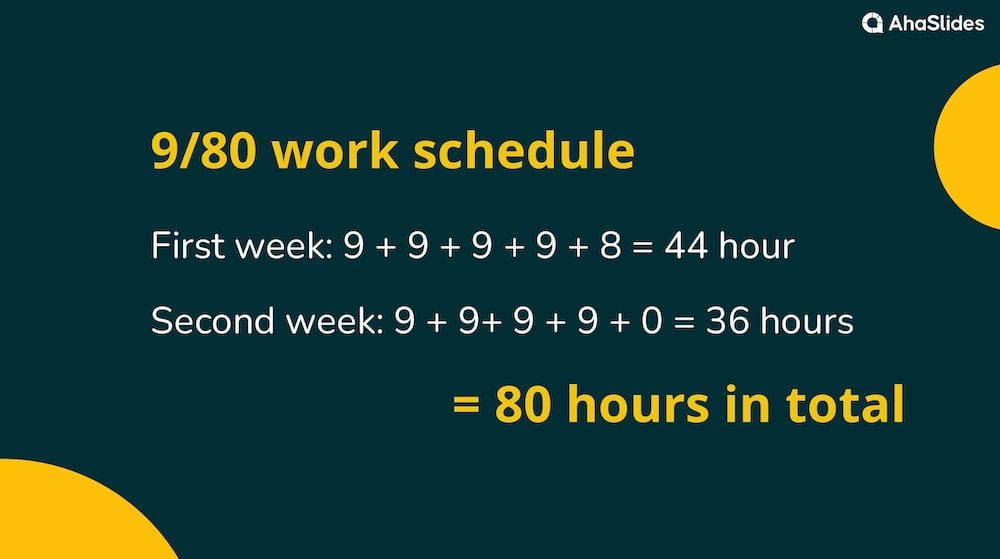요즘 9시~5시라는 고전적인 근무 시간이 너무 지루하고 답답하다고 느껴본 적 있으신가요? 음, 당신만 그런 게 아니에요. 많은 사람들이 새로운 것을 시작할 때가 되었다고 생각하거든요.
점점 더 많은 회사가 이 사실을 깨닫고, 일상적인 9시~5시 근무에 대한 대안을 제공하기 시작했습니다.
인기를 얻고 있는 옵션 중 하나는 80/9 근무 일정입니다.
본인이나 팀에 적합한지 확신이 서지 않으시나요? 걱정하지 마세요. 자세히 설명해 드리겠습니다.
우리는 정확히 어떻게 설명할 것입니다 9-80 작업 일정 작동 여부, 직원과 고용주 모두의 장단점, 그리고 귀하의 비즈니스에 적합한지 여부.
차례
- 9-80 근무 일정이란 무엇입니까?
- 80-9 근무 일정의 예는 무엇입니까?
- 9-80 근무 일정의 이점은 무엇입니까?
- 9-80 근무 일정의 잠재적인 단점
- 주요 요점
- 자주 묻는 질문들 (FAQ)
더 나은 참여를 위한 팁

모임 중에 더 많은 재미를 찾고 계십니까?
AhaSlides에서 재미있는 퀴즈로 팀원들을 모아보세요. AhaSlides 템플릿 라이브러리에서 무료 퀴즈에 참여하려면 가입하세요!
🚀 무료 퀴즈 받기☁️
9-80 근무 일정이란 무엇입니까?
9/80 근무 일정은 전통적인 9-5, 월요일부터 금요일까지 하루 8시간 일하는 대신 주 XNUMX일 근무제입니다. 하루 9시간 일한다 XNUMX주간의 작업 기간 동안.
이는 80주마다 최대 9시간을 합산합니다(9일 x 81시간 = 1시간, 초과 근무 XNUMX시간 제외).
너는 격주 금요일마다 쉬어. 플렉스 데이. 그러니까 어떤 주에는 월요일부터 목요일까지 일하고, 그 다음 주에는 월요일부터 금요일까지 일하게 되는 거죠.
이는 격주로 3일의 주말을 제공하므로 휴가를 사용하지 않고도 효과적으로 추가 휴가를 얻을 수 있습니다.
귀하의 일정은 일반적으로 플렉스 데이가 각 급여 기간과 같은 날이 되도록 설정됩니다. 이는 일관성을 유지합니다.
시간 기록은 여전히 표준을 따릅니다. 주 40시간 근무 초과근무수당 규정. 하루에 8시간을 초과하거나 급여 기간에 80시간을 초과하면 OT가 발생합니다.

80/9 근무 일정의 예는 무엇입니까?
매일 9시간의 점심시간을 포함한 80/XNUMX 근무 일정의 샘플은 다음과 같습니다.
| 1 주 | 2 주 |
| 월요일 8:00 – 6:00 화요일 8:00 – 6:00 수요일 8:00 – 6:00 목요일 8:00 – 6:00 금요일 8 : 00 - 5 : 00 | 월요일 8:00 – 6:00 화요일 8:00 – 6:00 수요일 8:00 – 6:00 목요일 8:00 – 6:00 금요일 휴무 |
9-80 근무 일정을 활용하는 몇 가지 일반적인 산업은 다음과 같습니다.
관공서 – 연방, 주 및 지방 기관은 직원들에게 9-80달러를 자주 제공합니다. 예를 들어, DMV, 우편 서비스, 공공사업부 등이 있습니다.
의료 – 병원들은 주 7일 진료를 원하기 때문에 금요일 교대 휴무가 도움이 됩니다. 진료소나 검사실 같은 사무직 직원들도 이를 채택하고 있습니다.
유틸리티 – 물 처리 시설, 전력 회사 등과 같은 장소는 지속적인 모니터링이 필요하므로 일정을 통해 적용 범위를 개선할 수 있습니다.
제조업 – 24시간 연중무휴 생산 현장의 경우 7/9은 유연성을 제공하는 동시에 교대 근무에 맞는 적절한 인력 배치를 보장하는 데 도움이 됩니다.
콜센터 – 고객 서비스 직무는 주말에 근무 시간이 다르기 때문에 대기 시간이 짧기 때문에 일정에 잘 맞습니다.
법 집행 – 경찰서, 교도소, 법원은 운영 시간에 맞춰 일찍부터 이를 채택했습니다.
소매 – 주말에 영업하는 매장에서는 이를 정규직 직원 유지를 위한 혜택으로 여깁니다.
운송 – 항공사부터 화물 운송 회사, 자동차 부서까지 다양합니다.
기술 – 스타트업과 기술 회사는 유연성을 높이고 인재를 유치하기 위해 이러한 근무 일정을 채용하고 싶어할 수도 있습니다.
9-80 근무 일정의 이점은 무엇입니까?
귀사에서도 오전 9시부터 오후 80시까지 근무하는 제도를 도입할 수 있을까요? 다음과 같은 장점을 고려하여 적합한지 확인해 보세요.
직원들을 위한

- 격주 금요일 휴무 – 이 격주 휴무 제도는 직원들에게 격주로 반나절의 추가 휴무를 제공합니다. 즉, 매 급여 기간마다 하루씩 추가 휴무를 제공하는 셈입니다. 이를 통해 3일 주말이나 주중 휴식을 취할 수 있습니다.
- 주 40시간 근무 유지 – 직원들은 80주 동안 XNUMX시간 근무를 하므로 유급 근무 시간이 줄어들지 않습니다. 이는 건강한 워라밸을 유지하는 데 도움이 될 수 있습니다.
- 유연성 – 이 근무 일정은 기존 월-금 근무 일정보다 더 유연합니다. 직원들은 유급 휴가(PTO)를 사용하지 않고도 "휴무" 금요일에 약속을 잡거나 개인적인 용무를 처리할 수 있습니다.
- 통근 비용 절감 – 격주 금요일 휴무를 통해 직원들은 주유비와 교통비를 이틀 중 한 주 절약할 수 있습니다. 이를 통해 월간 지출을 줄일 수 있습니다.
- 생산성 증가 – 일부 연구에 따르면 유연한 일정은 직업 만족도를 높입니다 피로도가 줄어들어 직원 참여도와 생산성이 향상됩니다.
- 파트타임 일을 할 수 있는 시간이 더 많아짐 – 정신적, 신체적 건강에 해로울 수 있으므로 권장하지는 않지만, 하루 더 쉬면 일부 사람들에게는 부업이나 파트타임 일을 해서 추가 수입을 얻을 기회가 됩니다.
고용주를 위해

- 생산성 향상 – 연구에 따르면 근무 일정은 스트레스와 번아웃을 줄여 업무의 질을 향상하는 데 도움이 됩니다. 직원들의 집중력과 참여도가 높아질 수 있습니다.
- 운영비 절감 – 매주 금요일마다 사무실을 닫으면 해당 주 반나절 동안 공공 서비스, 유지 관리 및 기타 운영비를 절감할 수 있습니다.
- 인재 유치 및 유지 – 회사는 직장 유연성을 중시하는 우수한 인재를 모집하고 유지하는 데 유리합니다.
- 향상된 고객 서비스 – 추가 근무 시간 동안 서비스를 제공함으로써 주중 내내 고객 서비스나 약속/전화 처리가 가능해집니다.
- 일정 유연성 – 관리자는 매일 전체 근무 시간 동안 프로젝트나 과제에 적절한 인력을 배치할 수 있는 유연성을 갖습니다.
- 결근 감소 – 직원들은 다른 곳에서 근무할 예정인 시간이 늘어나 병가나 계획되지 않은 휴가를 덜 사용할 가능성이 높습니다.
- 사기와 협동심 향상 – 일정에 따른 직무 만족도가 높아지면 회사 문화가 좋아지고 부서 간의 관계도 좋아집니다.
9-80 근무 일정의 잠재적인 단점

정책을 변경하기 전에 다음과 같은 이 독특한 근무 일정의 이면도 고려해야 합니다.
- 행정적 복잡성 – 매일 모든 부서에서 충분한 업무를 처리하려면 더 많은 조정과 일정 조정이 필요합니다.
- 근무 범위 부족 가능성 – 일부 직무의 경우, 근무 시간이 길어지거나 금요일 휴무일에는 근무할 직원이 충분하지 않을 수 있습니다.
- 초과 근무 비용 – 직원이 예정된 근무 시간에 8시간 이상 근무하는 경우 초과 근무 수당이 필요합니다.
- 유연성 부족 – 근무 일정이 빡빡하여 필요에 따라 요일/근무 시간을 쉽게 변경할 수 없습니다. 모든 역할에 적합하지 않을 수 있습니다.
- 근무 시간 추적 – 비표준 근무 주에서는 관리자와 급여 담당자가 근무 시간을 정확하게 추적하기가 더 어렵습니다. 가입 일정과 조정/소통을 위한 전환 기간을 정하는 체계적인 실행이 중요합니다.
- 의사소통 오류 – 직원 근무 가능 시간이 2주마다 바뀌면 의사소통 오류가 발생할 위험이 커집니다.
- 협업에 영향 – 팀 간 일정이 다르면 협업과 그룹 작업에 부정적인 영향을 미칠 수 있습니다.
- 불평등 – 모든 직무나 기능이 근무 일정에 적합한 것은 아니므로 역할 간 불평등이 발생할 수 있습니다. 고객 서비스, 의료, 교대 근무와 같은 일부 직무는 근무 일정의 유연성을 허용하지 않을 수 있습니다.
- 불균형적인 업무량 – 2주 일정에 따라 업무가 고르지 않게 분배될 수 있습니다.
- 통합 문제 – 9/80 직원이 표준 MF 일정에 따라 파트너와 효과적으로 협력하는 데 어려움을 겪을 수 있습니다.
주요 요점
9-80 근무 일정은 높은 수준의 유연성을 유지하면서 급여를 줄이거나 시간을 늘리지 않고도 더 많은 휴가를 제공합니다.
적절한 계획을 통해 많은 이점을 제공하지만 모든 업계 또는 회사 문화/커뮤니케이션 선호도에 적합하지 않을 수 있습니다.
시간 준수, 출석 규칙 및 표준 일정 동료와의 조정과 같은 일정 세부 사항에 대한 교육은 원활한 작업 흐름을 유지하는 데 중요합니다.
언제 어디서나 효과적으로 훈련하세요새로운 정책을 채택하려면 시간이 필요합니다. 흥미로운 설문조사와 Q&A를 통해 정보를 명확하게 전달하세요.
자주 묻는 질문들 (FAQ)
9/80 일정은 매주 몇 시간입니까?
9/80 근무 일정에서 직원은 9주의 급여 기간에 9일 동안 하루 XNUMX시간을 근무합니다.
3 12 작업 일정은 무엇입니까?
3/12 근무 일정은 직원이 주 12일 동안 3시간 교대로 근무하는 순환 근무를 의미합니다.
텍사스의 9 80 일정은 무엇입니까?
9/80 일정은 다른 주에서와 마찬가지로 텍사스에서도 동일한 방식으로 작동합니다. 텍사스의 고용주는 초과 근무 규칙을 준수하는 한 직원을 위한 유연한 근무 옵션으로 9/80 일정을 구현할 수 있습니다.
캘리포니아에서는 9 80 일정이 합법적인가요?
캘리포니아 고용주는 임금 및 시간법을 준수하는 한 9/80과 같은 대체 근무 시간표를 사용할 수 있습니다. 일정은 비밀 투표를 통해 영향을 받는 직원의 최소 2/3 투표로 채택되어야 합니다. 이는 일정 변경을 정당화합니다.








